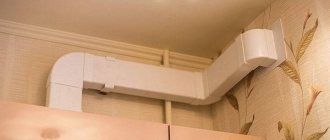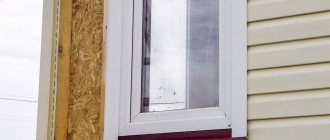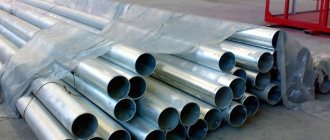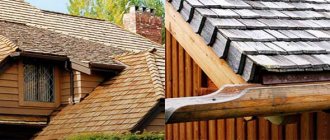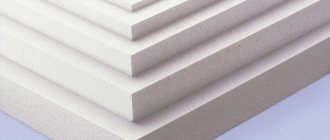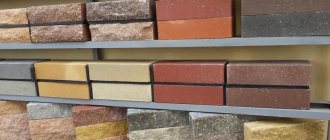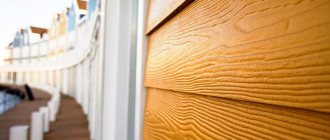Tension fabrics are a popular type of arrangement of suspended ceiling coverings. They are widely used in government agencies, public institutions, residential buildings and apartments, in those areas where fire safety standards allow. As in any suspended structure, ventilation in a suspended ceiling is one of the most important engineering structures.
Unfortunately, there are many companies that can beautifully install an impressive coating, but only after many installers do problems with the microclimate in the room begin, due to illiterate installation of the ventilation system
How to control the creation of proper air exchange, what calculations must be made, what scheme to choose and what standards exist in apartments where it is impossible to install new channels in load-bearing structures? There are so many questions, but we have answers to everything. We will talk about arrangement options and design features of a suspended ceiling ventilation system.
Types of ventilation for suspended ceilings
High-quality ventilation will help get rid of possible problems, including the formation of mold and other activity of harmful microorganisms, the appearance of rust and the formation of condensation.
There are two key types of ventilation: natural and artificial.
Natural ventilation
This option is suitable for rooms that already have a functioning hood. Often such structures are located in the bathroom and kitchen. This is the most affordable type of ventilation that fully complies with the requirements of sanitary standards. In order for the change of air masses to be as fast as possible, it is necessary that fresh air flows penetrate into the room without obstacles, displacing carbon dioxide.
The entry of air masses occurs through cracks, windows and doors. In turn, carbon dioxide rises and is removed from the room through an exhaust hood located in the bathroom, kitchen or toilet.
This type of ventilation is the most economical to carry out an exhaust hood under a suspended ceiling, since operation does not require additional equipment or energy resources. However, this system has several disadvantages. In order for natural ventilation to provide air change, it is necessary that nothing obstructs the air masses. Another disadvantage was the fact that the basis for the operation of ventilation is the temperature difference. And this is only possible during cold periods, which reduces the work of air exchange.
Artificial ventilation
This type of ventilation is also known as mechanical. This is explained by the fact that for the normal functioning of air exchange, additional equipment is used, the task of which is to constantly change the air in the room. Often this is the only way to ensure a stable indoor microclimate.
The artificial ventilation system consists of several elements, including a fan, an air filter and an air heater. Being components of a single system, their work ensures the circulation of air masses over a large area. The only caveat is that energy resources are required for operation. If for some reason the voltage weakens or disappears, the ventilation system will not work.
Criterias of choice
The visual appeal of a ceiling hood is certainly important, but it is a workhorse, and its capabilities should be taken into account when purchasing. You should definitely pay attention to the following technical characteristics:
- Power, aka productivity. During an hour of operation, kitchen exhaust ventilation must provide a twelvefold exchange of air - these are the sanitary requirements for it. The power is selected based on the volume of the room for which the hood is planned. V (m) = Length x Width x Height. To reach the required power, the resulting value is multiplied by 12, an additional compensation of 15% is added for the resistance of the filters and 5% for losses at each bend of the air duct. The technical data sheet of the device should contain a figure slightly larger than that obtained as a result of calculations - with a margin. Up to 400 m3/hour productivity is considered low, 600-1000 “cubes” is considered high.
- Noise level. Everything is simple here: expensive ones make less noise, cheap ones make more noise. A comfortable value for the ears is 35-45 dB.
- Size. It is located in accordance with the hob and can be 50, 60, 90 cm. For better absorption of emissions, the dimensions of the hood should exceed the dimensions of the stove by 10-20 cm.
- Electronic control. The island hood in the price segment from the middle and above is equipped with a remote control unit.
- Additional functions. This could be a built-in backlight. The functions of a local light source are performed by fluorescent, halogen or LED lamps. In some models, the degree of illumination is adjustable. The presence sensor is responsible for this. A variety of indicators increase the functionality of the device. Thus, the built-in filter clogging detector (ultrasonic density sensor) will report its unusability, and the timer will turn off the device after the required period of time. Fans of fresh air may want to pay attention to the ability to turn the hood on/off at intervals. In this case, the fan will automatically turn on, for example, once an hour and ventilate the room.
How to make a hood under a suspended ceiling
Installing an exhaust structure is quite a difficult task. However, you can cope with it yourself, having certain knowledge and skills. To prevent possible problems, it is necessary to involve experienced specialists who know what is needed to install a hood.
Before installing PVC, you must perform a number of mandatory operations:
- thermal insulation of the concrete base of the ceiling, which will significantly reduce the amount of condensation;
- sealing all seams and joints of ceiling and wall structures;
- strengthening the surface of the ceiling base using special building compounds. This will prevent the plaster and concrete particles from falling off;
- all wooden ceiling surfaces must be treated with antiseptics and fire retardants;
- The inter-ceiling coating is treated with special substances to prevent the penetration of rodents and insects.
Once the base of the ceiling is prepared, you can begin laying ventilation ducts, after which the PVC will be installed. Particular attention should be paid to the installation of ventilation grilles that will be responsible for air exchange.
Installation of this structure is carried out according to the following scheme:
- before installing the PVC sheet, it is necessary to secure the air ducts, stretch the wiring, fix the exhaust duct under the suspended ceiling, and check the tightness of all joints;
- after this, a PVC sheet is installed, in which holes are carefully cut according to the size of the ventilation grilles;
- To ensure that the holes for the hood in the suspended ceiling do not lead to deformation, protector rings are put on them, after which a ventilation grill is mounted and secured in the resulting opening.
How to make a hood in a suspended ceiling in a bathroom
If the bathroom has functioning ventilation, there will be no problems with installation. For it to work well, it will be enough to install ventilation grilles on opposite sides of the PVC structure. They need to be fixed using adhesive. The grille will be attached to the outer surface, after which you need to cut out part of the film from the inside.
If the bathroom does not have an exhaust structure, you will need to install it yourself. To ensure air exchange, you need to install an artificial ventilation system. To do this, prepare all elements of the system, including the heater, fan and air filters. Before installing PVC, it is worth laying cable channels for laying electrical wiring and ensuring the installation of a hood.
The specificity of installing a hood in a bathroom is that air masses must change constantly. Foreign odors may accumulate in this room, so the task of ventilation will be to remove them in a timely manner.
In order for the work to be completed to the highest possible quality, it is necessary to initially calculate and install the system:
- determining locations for installing exhaust pipes;
- laying pipes for exhaust hood under a suspended ceiling, electrical wiring;
- fixing all hood elements to the concrete base of the ceiling;
- installation of a stretch ceiling, including installation of fastening baguettes and tensioning of the canvas;
- fastening of decorative grilles that will mask the ventilation ducts.
How to make a hood in a suspended ceiling in the kitchen
The installation of a hood in a suspended ceiling in the kitchen follows strict regulations, consisting of a number of mandatory actions:
- Electrical power is supplied to the location of the fume hood. All switches and sockets must be grounded.
- Using a simple pencil, you need to mark the place where the structure will be fixed in the suspended ceiling. If it is located at a considerable distance from the ventilation shaft, it is necessary to use flat pipes for air circulation, which will be hidden behind the suspended ceiling.
- After marking, fasteners are applied to the ceiling base and places for self-tapping screws are marked. It is recommended to use anchor bolts as fastening elements.
- Prepare the air duct assembly for exhaust under the suspended ceiling. If it consists of several parts, they must be fixed together with sealant.
- The ventilation duct is attached to the shaft. It is necessary that the position of all parts of the structure be correct. You can verify this using a building level.
- After everything is securely fixed, you can proceed to the installation of PVC. First you need to make holes on it and attach tread rings to them. Pipes responsible for air exchange are discharged through them.
Important! The installation process is completed by connecting the hood with a conductive channel. To make the design more aesthetically pleasing, you can install a decorative hood for suspended ceilings that will match the interior of the kitchen space.
Good care - long service life
A ceiling hood for the kitchen is not a cheap purchase. The quality of work and preservation of appearance are directly related to how well it is cared for. Grease splashes, soot stains and settling dust cannot be avoided. With the help of a sponge and modern soft, fat-soluble products, it is easy to maintain cleanliness.
Aggressive abrasive compounds cannot be used. Performance decreases if clogged filters are used. Failure to change or clean them in a timely manner may adversely affect the performance of the engine. Before you start cleaning the hood and replacing (washing) filters, you need to disconnect the device from the mains. By the way, the outlet for the hood must be individual and grounded. After all parts have completely dried, the device can be turned on again.
The choice of ceiling hood must be approached carefully. Only then there will be no disappointments, and an effective, convenient and perfectly functioning installation will delight and take care of the health of your household for a long time. It’s a good idea to study manufacturers, market prices in advance, compare different models by design, power and functionality, and look at the warranty period. Again, it is important that the hood fits into the interior, and that the “smart” filling turns out to be optimal. Information from reviews left by customers on online sites will also be of some help.
How to hide a hood under a suspended ceiling
PVC coating is in demand due to the high aesthetics of the structure. Installing ventilation can affect decorative parameters. Therefore, when installing a ventilation system, it is necessary to hide the corrugation from the hood under the suspended ceiling.
To do this, before tensioning the canvas, you need to install a special box made of plasterboard or PVC. In this case, the operation of the unit will be as quiet and noiseless as possible, vibration and possible air fluctuations will not affect the PVC sheet.
Another option to hide the pipe from the hood under the suspended ceiling is to install a two-level PVC structure. It is enough to lower the level above the area where the hood is located so that its elements are not noticeable. This option is the most preferable, as it will allow you to create a unique structure with an interesting design.
Design features
Engineering thought very inventively approached the constructive solution of the island ventilation system. The choice of models is quite large and meets a wide variety of tastes and needs. Let's look at some distinctive features:
- Housing (the engine is located in it). The case material also varies. The most resistant to vapors, grease, soot, and temperature changes are aluminum, steel, and tempered glass. But there are lovers of wood, plastic, and ceramics.
- Hanging system. Usually these are either cables or 4 studs with collets. A more expensive option is a floating suspension that allows you to adjust the height.
- Stationary and folding (mobile). When not in use, the latter are raised to the ceiling. During operation, special sensors regulate the height of the hood above the cooking surface.
Let's take a closer look at the case. Externally, it may look different:
- T-shaped option. Designed in the form of a thin flat or curved panel. Looks light and does not clutter the interior; Such hoods are convenient to install. In this case, only the fence panel is visible.
- Dome (lampshade, drop, inverted glass). Such shapes, combined with a powerful engine, perfectly purify the air. They fit perfectly into a retro interior or decorate a spacious, bright room decorated in high-tech style.
- Geometric shapes: cylinder, rectangle, square, plate, pipes.
Tips and tricks
Experts recommend adhering to the following tips when installing ventilation:
- After installing the hood in a suspended ceiling, you must check that its components do not come into contact with each other. Otherwise, the vibrations and vibrations that occur during fan operation will affect the PVC coating. As a result, the canvas may become deformed, which will negatively affect functionality.
- It is not recommended to seal gaps in the ventilation shaft with foam. If you install a ventilation grille in the opposite part of the PVC, even when the ventilation is not working, air exchange will take place.
- The suspended ceiling and the hood from the gas water heater must be harmonious. Therefore, to ensure safety, it is necessary to hide the ventilation elements in special decorative boxes.
- When installing the exhaust unit, it is necessary to ensure that all elements are secured as firmly as possible. Otherwise, vibration will occur during ventilation operation. It will affect the aesthetics of the coating, as the canvas will constantly vibrate.
Important! Before installing PVC, it is recommended to increase the level of waterproofing of the concrete base. This is explained by the fact that the presence of a ventilation grill reduces the tightness of the structure. Such a canvas will not save you from a flood from above.
Power
Another name for this characteristic is performance. The unit of measurement in this case is m3/hour: this allows you to understand how much air can pass through the device per unit of time. A ceiling-mounted hood can have a capacity of 500-1500 m3/hour.
According to standards, kitchen air must be renewed 12 times within an hour. Based on this, in order to determine the optimal performance of the exhaust system, it is necessary to multiply the volume of the kitchen by 12. In order for the calculation to be as accurate as possible, the volume of furniture installed in it is subtracted from the total volume of the room.
Scope of application
Plastic ventilation ducts in the wall
According to SNiP, plastic air ducts are allowed to be used in the following buildings:
- administrative and household;
- residential;
- public;
- production (category D).
In addition, these buildings must be low-rise. It is prohibited to lay such air ducts in the following parts of the building:
- subfloors;
- basements;
- technical floors;
- attics.
Also, you should not install plastic boxes if this promises problems with the fire service.
There are known situations where, when it was discovered that the ventilation elements were made of plastic, permission to install gas equipment (boiler, water heater, etc.) was not given.
To prevent this from happening, you should consult with a fire inspector about this in advance or carefully read the regulatory documents.
And such bans are not introduced in vain, because, as mentioned earlier, it is dangerous to use plastic if it can be exposed to high temperatures.
This should be taken into account when installing air ducts near electric motors or heaters (of any kind), because in the event of any ignition of such a device, harm will be caused not only to the ventilation system itself, but also to all people in the room.
Results
Ceiling-mounted kitchen hoods are fairly effective modern equipment that can be used to purify the air in the kitchen from various fumes that arise during cooking. In addition to the medical effect, this measure allows you to increase the service life of finishing materials: it is no secret that it is the accumulation of soot and grease that is the main reason for renovations in the kitchen. Ceiling hood models have greater power, so it makes sense to use them in large rooms. If the kitchen is small, you can limit yourself to a cheaper wall-mounted model.
Additional equipment
Some additional options may be introduced into the kitchen ceiling hood equipment, which is influenced by the class of equipment. This allows you to make the operation of the equipment more convenient and efficient.
As a rule, we are talking about the following additional functions:
- The ability to automatically start after the hob starts operating.
- Self-regulating power. The intensity of functioning can have several modes - weak, medium and high. This makes it possible to choose the optimal level of purification, depending on the degree of air pollution.
- Programming a schedule for turning on equipment. For this purpose, various time intervals can be entered.
- Internal lighting. This makes the operation of the work area more convenient.
- Filter sensor. It shows the level of contamination of the cleaning elements, which makes it possible to change them in a timely manner.
- Remote control with buttons for all functions and modes.
- Residual lead. The hood will operate for a specified period of time after the hob is deactivated.
Every year the list of additional options is expanded, which is explained by the constant improvement of electronic and automatic equipment. The cost of a kitchen hood in the ceiling is largely influenced by the class of equipment.
Types of finishes
The following types of drywall are distinguished:
- Ordinary. Designed for finishing any surface of a room with a low level of humidity, as well as creating interior partitions.
- Fire resistant. The sheet is not subject to combustion due to its composition.
- Moisture resistant. It has special impregnations and has water-repellent properties that prevent the formation and proliferation of mold. Used in rooms with high humidity.
Drywall is suitable for making various arches that go from the wall to the ceiling. Experts recommend using plasterboard sheets with a thickness of no more than 9 mm for the ceiling, otherwise the structure may not support its weight. When purchasing such products, pay special attention to their quality. Sheets must be clean, without traces of water or fungus, and stored strictly in a horizontal position.
